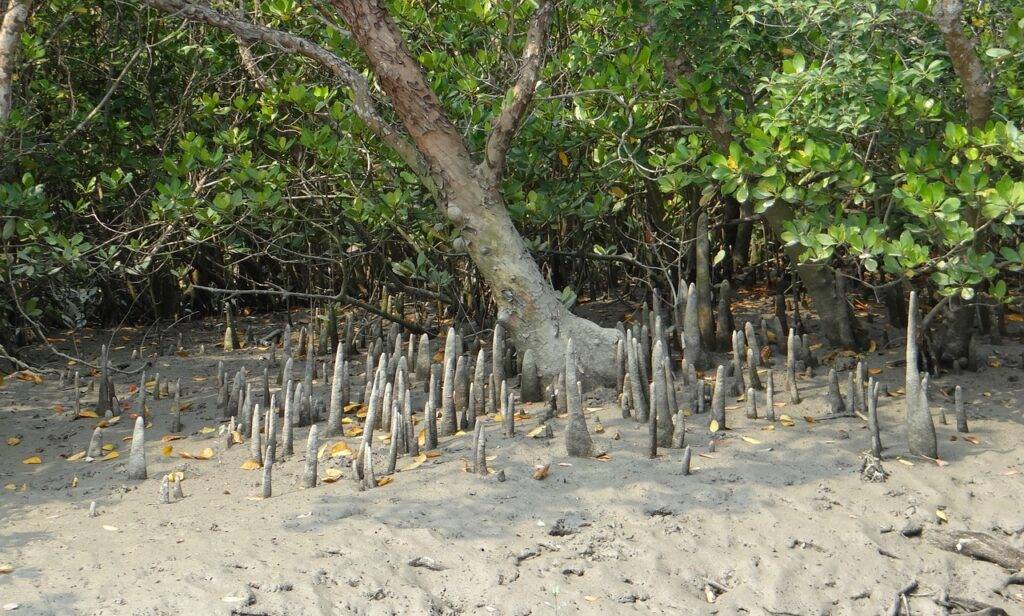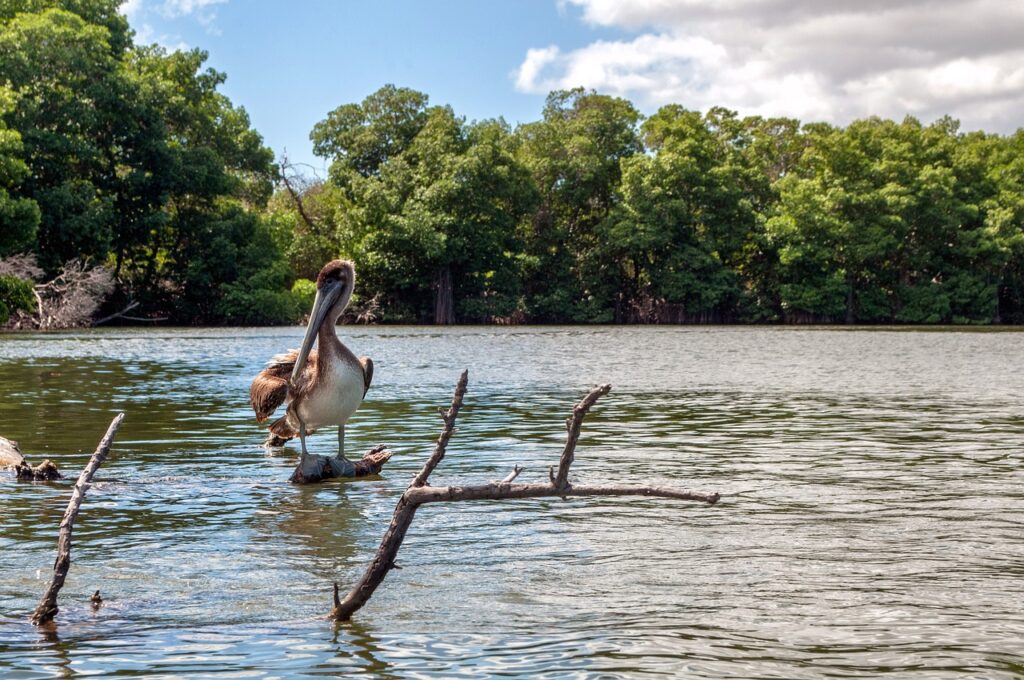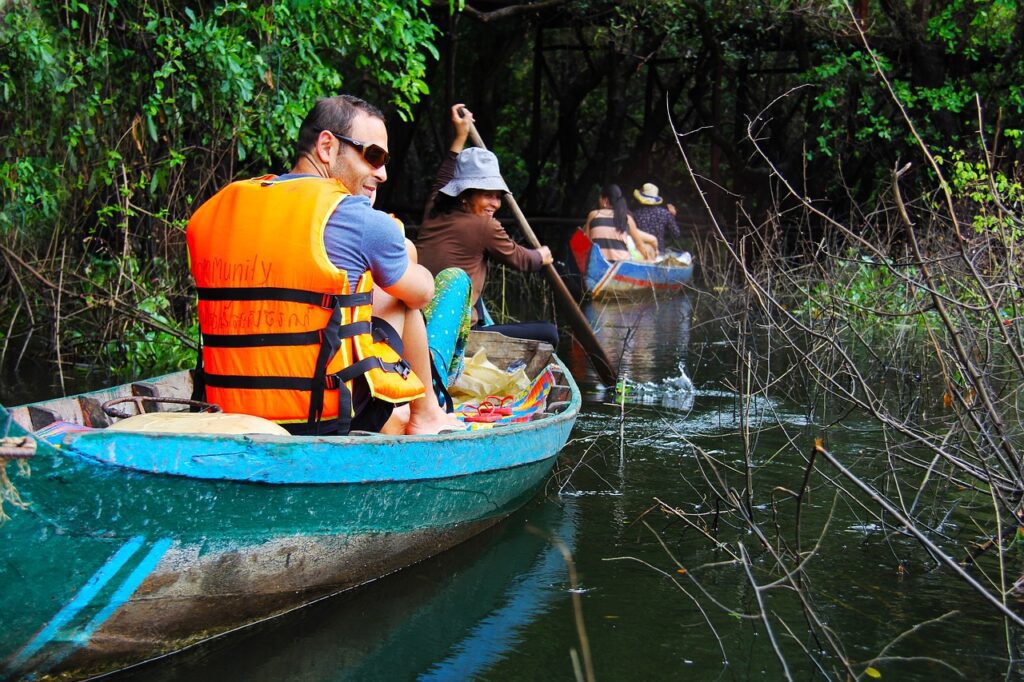
Mangroves, often referred to as the “rainforests by the sea,” are extraordinary ecosystems that flourish in intertidal zones, bridging the gap between terrestrial and marine environments. They can be found in tropical and subtropical regions around the world, including areas with muddy, saline, or brackish waters. These resilient environments are characterized by their salt-tolerant flora and intricate root systems that provide numerous benefits to both the environment and human society. Now the question is why mangroves are considered real superheroes of the environment. To get the answer let’s see what kind of roles mangroves are playing to sustain our planet.
There are several species of mangroves, each with its unique adaptations. Some common species include the Red Mangrove, Black Mangrove, and White Mangrove, each contributing to the ecosystem’s diversity and functionality. Mangroves have evolved various adaptations to cope with their challenging surroundings. Their specialized root systems, such as prop roots and pneumatophores, enable them to anchor in unstable soil and access oxygen in waterlogged conditions. Therefore, mangroves are recognized as being among the most important ecosystems in the world for the array of ecosystem services they provide.
Environmental Superpowers: Mangroves’ Key Roles
1. Protect from storms and hurricane
Mangroves typically have dense vegetation comprising various species of salt-tolerant trees and shrubs. This density acts as a natural barrier, absorbing and dissipating the energy of incoming waves. Moreover, stilt-like roots extend above the waterline and trap sediments and debris, creating a natural buffer that can absorb wave energy and prevent erosion. In addition, mangroves often have intricate root systems that spread out both vertically and horizontally. These roots stabilize the shoreline by binding the soil and preventing erosion, effectively holding the coast together.
When waves from storms approach the coastline, they carry a significant amount of energy that can cause erosion and damage to coastal infrastructure. Mangroves have evolved mechanisms to dissipate wave energy, minimizing the impact on the coast. As waves approach mangrove forests, the dense vegetation and root structures cause waves to be reflected and deflected in various directions. This disperses the energy over a larger area, reducing the intensity of waves that reach the shore. In addition, the stilt-like roots and complex root systems create drag and friction as waves pass through them. This slows down the waves and decreases their energy, effectively dampening their impact on the coastline.
A notable example of mangroves’ storm protection abilities is demonstrated by the impact of Hurricane Mitch in Honduras in 1998. The Bay Islands, which had healthy mangrove ecosystems, experienced significantly less damage compared to other regions without mangroves. The intact mangroves absorbed a substantial amount of the hurricane’s energy, reducing the height and intensity of the storm surge and preventing widespread destruction.
2. Stabilize shoreline
Mangroves have unique root adaptations, such as prop roots and pneumatophores. These structures grow above the waterline and anchor the trees in the soil, preventing them from being uprooted by waves and currents. The extensive network of mangrove roots helps bind and stabilize the soil. This network creates a natural barrier against erosion by holding the sediment in place and preventing it from being washed away.
The intricate root systems of mangroves act as natural filters, trapping sediments suspended in the water. This process not only improves water quality but also builds up sediment layers around the mangrove trees. Over time, the trapped sediments accumulate around the roots of mangroves, gradually building up the land surface. This land-building process enhances the elevation of coastal areas, providing a buffer against coastal erosion and storm surges. That is why mangroves are considered real superheroes of the environment.
3. Prevent soil erosion
Soil erosion, a widespread environmental challenge, is caused by factors such as water runoff and wind force. Erosion can lead to habitat destruction, reduced water quality, and economic losses. Water erosion occurs when rainwater or tidal currents carry away the top layer of soil. This process is prevalent in coastal regions, where wave action can intensify erosion. Wind erosion involves the detachment and transport of soil particles by wind. In coastal areas, strong winds can carry away loose soil, leaving behind barren landscapes.
Mangroves stand as nature’s defenders, safeguarding coastlines from the relentless forces of erosion. Their intricate root systems, wave energy dissipation, and sediment-trapping abilities create a dynamic defence mechanism that benefits both the environment and coastal communities. These roles are very specific and crucial to protect our planet.
4. The breeding ground of many aquatic animals
Mangroves are not just coastal habitats; they are bustling nurseries for a diverse range of aquatic animals. These unique ecosystems provide ideal conditions for various species to reproduce, grow, and thrive. Nursery habitats are critical for aquatic animals’ survival during their early life stages. Mangroves offer protection, abundant food, and optimal environmental conditions for these delicate organisms to develop. Moreover, its complex root systems and dense vegetation provide refuge from predators. The labyrinthine roots create hiding places, helping juvenile animals escape from larger predators that roam open waters.
Mangroves’ intricate network of roots slows down water currents, creating sheltered and calm waters. These conditions are ideal for small aquatic animals that require stability for feeding and growth. In addition, it contributes to nutrient cycling by trapping organic matter from tidal waters. The decaying leaves and detritus serve as food sources for microorganisms and small animals, forming the base of the food web.
Many commercially important aquatic species use mangroves as nurseries. Many species of fish, shellfish, crustaceans, reptiles, and amphibians rely on the shelter and abundant food provided by mangrove habitats during their early life stages.
Scientific studies have shown that aquatic animals reared in mangrove nurseries experience higher growth and survival rates compared to those in less protected environments. Therefore, mangrove nurseries contribute to enhancing biodiversity by supporting a wide range of species during their early life stages. This diversity strengthens the resilience of marine ecosystems.

5. Minimize flood risk
Flood risk arises from various sources, including heavy rainfall, storm surges, and rising river levels. Coastal and riverine flooding can result in property damage, infrastructure disruption, and loss of life. Floods can have devastating effects on communities and ecosystems. Inhabitants of flood-prone regions face displacement, economic hardships, and health risks. Ecosystems also suffer from sediment deposition and water quality deterioration.
Mangroves, the guardians of coastal ecosystems, play a crucial role in minimizing flood risks by acting as natural barriers that absorb, attenuate, and redirect floodwaters. Their intricate root systems, sediment trapping abilities, and unique adaptations create dynamic flood mitigation.
Mangroves have extensive root systems that stabilize soil and prevent erosion. These roots act as natural barriers, absorbing water and reducing the speed and impact of floodwaters. Additionally, mangroves trap sediments carried by floodwaters, gradually building up the land surface. This process enhances elevation, creating natural buffers against floodwaters and storm surges. This leads to slowing down floodwaters and reducing hydraulic pressure. This hydraulic moderation minimizes the risk of flooding in downstream areas.
Moreover, mangroves dissipate the energy of incoming waves, reducing the erosive impact of waves on shorelines. This wave energy attenuation minimizes coastal flooding during storms. Furthermore, mangroves absorb excess water during floods, acting as natural sponges. The absorbed water is gradually released back into the environment, reducing the volume and speed of floodwaters.
The Sundarbans mangrove forest in Bangladesh and India serves as a prime example of flood protection. During cyclones, the mangroves absorb floodwaters and reduce the impact of storm surges on coastal communities. It supports the livelihood of 4.5 million people and acts as a haven for many globally endangered plants and animals.
6. Provide jobs and food security
Mangroves are ecological powerhouses that extend their benefits beyond the environment. They play a pivotal role in supporting the livelihoods of coastal communities and ensuring food security for countless individuals.
- Mangroves provide fertile grounds for aquaculture and fishing activities. Many fish species, crustaceans, and molluscs find refuge and food within mangrove ecosystems, creating direct and indirect employment opportunities.
- Coastal communities heavily rely on mangrove fisheries for their daily sustenance. Mangrove habitats serve as nurseries for fish, shrimps, and crabs, contributing to a consistent and reliable source of protein.
- Apart from seafood, mangroves provide resources like honey, timber, and medicinal plants. These supplementary resources contribute to the overall well-being of communities and their resilience.
- Mangrove-related activities, such as fishing, aquaculture, and ecotourism, offer direct employment opportunities. These jobs provide income and support livelihoods for coastal residents.
- The economic impact of mangroves extends beyond direct employment. Industries related to the processing, transportation, and distribution of mangrove-related products further contribute to local and regional economies.
- Mangroves support sustainable fishing practices by acting as breeding and nursery grounds for aquatic species. Implementing responsible fishing regulations ensures the long-term availability of resources.
- Traditional knowledge passed down through generations helps coastal communities manage mangrove resources sustainably. Practices like selective harvesting and seasonal fishing contribute to food security.
- Local communities have long utilized mangrove plants for their medicinal properties. Traditional remedies derived from mangrove species are used to treat various ailments, showcasing the cultural significance of these ecosystems.
Countries like Indonesia and Thailand have vibrant mangrove-based economies. Fishing, aquaculture, and ecotourism provide livelihoods for coastal populations, enhancing food security and economic stability.
In countries like Mexico and Brazil, mangrove ecosystems offer valuable resources and employment opportunities. Communities engage in sustainable fishing and aquaculture practices, ensuring their food security.
7. Provide habitat for an array of animals
Mangrove ecosystems support thriving fisheries by providing nurseries and habitats for many commercially valuable fish species. Because of that millions of people depend on mangrove forests for their livelihoods and sustenance. Indeed, dynamic ecosystems and rich ecological interactions, serve as biodiversity hotspots that host an impressive variety of animal species. These habitats offer a unique blend of conditions that support an array of life forms.
Mangrove roots create microhabitats that support various organisms. These roots provide attachment points for barnacles, oysters, and other filter-feeding organisms, contributing to the overall biodiversity.
The Amazon rainforest’s mangroves are home to diverse animal species, including manatees, caimans, and various bird species. These habitats support both terrestrial and aquatic fauna, forming intricate ecological networks. For example, mangroves in the Indo-Pacific region host diverse marine life, from seahorses and mudskippers to estuarine crocodiles. These ecosystems showcase the adaptability of animals to intertidal conditions.
8. Tourism and Recreation
Mangrove-rich areas attract many eco-tourism and recreational activities. For example, guided tours, bird-watching, and kayaking expeditions contribute to local economies by generating jobs in the hospitality and tourism sectors. About 5% of eco-tourism and recreational activities in the world are supported by mangrove ecosystems.

9. Biodiversity Hotspots
Mangrove ecosystems have low plant diversity as compared to other ecosystems. But it provides a haven for several species, from crustaceans to large birds. Moreover, the dense tangle of roots and foliage creates a complex habitat where various organisms find food, shelter, and breeding grounds.
10. Carbon Sequestration
Mangroves are highly efficient carbon sinks, absorbing atmospheric carbon dioxide and storing carbon in their biomass and sediments. Therefore, this vital ecosystem service is crucial in mitigating climate change. Mangrove plants are 2 to 4 times higher productive than mature tropical forests. The average annual carbon sequestration rate of mangrove ecosystems is 6 to 8 tons of CO2 per hectare.
Threats to Mangroves
Rising sea levels and increased temperatures pose significant threats to mangrove ecosystems. As sea levels rise, these habitats could face inundation, leading to habitat loss and ecosystem disruption. In addition, urban development and agriculture activities have led to clear mangrove areas. This reduces habitat availability and also disrupts the delicate balance of coastal ecosystems. Moreover, pollution from land-based sources and oil spills can have catastrophic effects on mangrove ecosystems. Contaminants can poison water, soil, and organisms, resulting in long-lasting damage.
Conservation Efforts
Designating protected areas and reserves is crucial for conserving mangrove ecosystems. These areas help mitigate human activities and provide safe havens for the diverse species that call mangroves home. In addition, engaging local communities in mangrove conservation is vital. When communities are directly involved in protection, they become stewards of their natural heritage. Moreover, educating the public about the importance of mangroves is crucial for their preservation. Campaigns, workshops, and school programs can empower people to take action and support conservation efforts. Therefore, public awareness plays a vital role in the conservation of mangroves.
For example, efforts to protect the Sundarbans mangrove forest have included community-based management and sustainable resource use. The Sundarbans mangrove forest is a UNESCO World Heritage Site known for its rich biodiversity. Similarly, the restoration of mangroves in Biscayne Bay has been a significant success through collaborative efforts, and degraded areas have been revitalized.
The Future of Mangroves
Scientists are exploring ways to create climate-resilient mangrove plantations. These plantations could provide habitat and protection while adapting to changing environmental conditions. Ongoing research into mangrove ecology, genetics, and restoration techniques is essential for informed conservation strategies. Innovative approaches can lead to more effective protection and restoration efforts. Moreover, advocacy for mangrove protection at national and international levels is crucial. Strong policies can ensure the long-term survival of mangrove ecosystems and the benefits they offer.
Conclusion
Indeed, mangroves are not just ordinary trees; they are unsung real superheroes working silently to sustain our environment. From coastal protection to supporting livelihoods, these ecosystems offer several benefits. It’s our responsibility to recognize their significance and work collectively to conserve and protect them for future generations.

